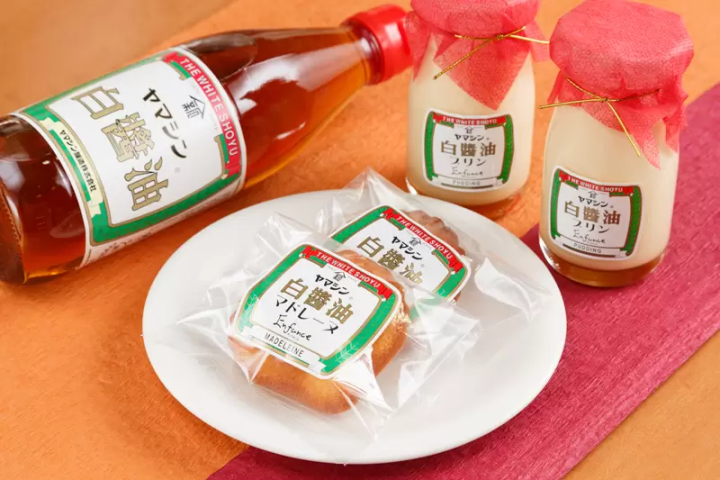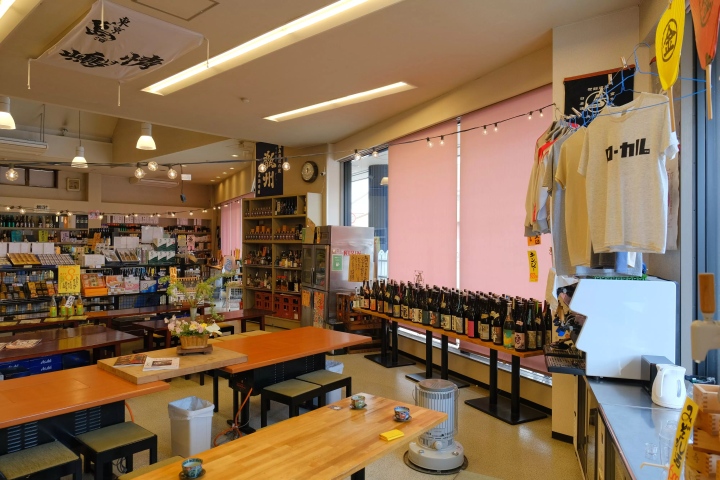Hekinan: Culinary Delights in the Hometown of White Soy Sauce

White soy sauce, with its light color and distinct sweetness, enhances both savory dishes and desserts. Experience its unique flavor in Hekinan City, the birthplace of white soy sauce, and savor some of Japan's finest cuisine.
Situated south of Nagoya and overlooking Mikawa Bay, Hekinan is a manufacturing city with a rich culinary history. Notably, it's the origin of white soy sauce and white dashi, and the location of Kokonoe Mirin, the brewery that originated Mikawa Mirin in Japan. These key fermented ingredients play a vital role in Japanese cuisine.
We invite you to embark on a culinary journey to Hekinan to taste and learn how these unique products transform the flavor of dishes.
-
Table of Contents
- 1. Arigato no Sato: Discover Well-Kept Secrets of Japanese Cuisine
- 2. Enfance : Try Exquisite Desserts Made with White Soy Sauce
- 3. Kobanten: Enjoy First-Class Hitsumabushi - Coal-Grilled Unagi Eel, a Specialty of Nagoya
- 4. Kinbara Saketen: Find Local Souvenirs, from Beverages to Snacks and Crafts
- 5. Kokonoe Mirin: Taste Heavenly Desserts Using Mirin, the Secret Ingredient of Japanese Cuisine
- Access: How to Get to Hekinan
1. Arigato no Sato: Discover Well-Kept Secrets of Japanese Cuisine

Begin your exploration of Hekinan's culinary treasures at Arigato no Sato, a facility run by Hichifuku Brewing Co., Ltd. Established in 1950, Shichifuku Brewing is the original producer of white soy sauce and white dashi; it is currently the only manufacturer with JAS organic certification for its white soy sauce.
Soy sauce is made by fermenting soybeans and wheat, but the main difference between white soy sauce and regular soy sauce is the ratio of the ingredients used. The ingredients of regular soy sauce are made from a 50/50 ratio of soybeans and wheat, but in the case of white soy sauce, about 90% consists of wheat, with only a small amount of soybeans used. This gives white soy sauce its characteristic light color and higher sugar content, allowing it to accentuate the natural flavors of other ingredients in a dish.
White dashi, a delicate Japanese soup stock soy sauce, is crafted by blending organic white soy sauce with dashi made from premium ingredients: rare Hongare bonito flakes, dried shiitake mushrooms, and Hokkaido kelp. This versatile stock serves as a base for various Japanese dishes, including miso soup, omelets, and simmered dishes.
Hichifuku Brewing Co., Ltd. takes pride in pioneering white dashi, meticulously selecting ingredients and managing production to ensure exceptional quality.

Discover the art of white soy sauce and white dashi production with a captivating tour of the Hichifuku Brewery at Arigato no Sato. Witness the craftsmanship, explore historical displays, and see the equipment firsthand! A highlight of the tour is the tasting session, where you'll savor dishes like a light soup, fluffy omelet, and crisp pickles, all enhanced by the brewery's signature ingredients.

You can recreate these culinary delights at home by purchasing Hichifuku Brewery's products at their shop, including vegetarian vegetable white dashi, “Kyo mo Tamagoyaki ♪” omelet seasoning, and unique white soy sauce-infused treats.
2. Enfance : Try Exquisite Desserts Made with White Soy Sauce

Enfance,a charming confectionery in Hekinan, is the creation of a skilled patissier who returned to his hometown after training in Nagoya, Tokyo, and Chiba. The shop features a diverse selection of handcrafted cakes, puddings, and baked goods.
In recent years, Enfance has gained popularity for its innovative desserts incorporating local ingredients like white soy sauce and Hatcho miso. A must-try is their Shiroshoyu Pudding (370 yen), a unique treat flavored with white soy sauce. For a comparative tasting experience, consider trying their regular pudding as well.

The Shiroshoyu Pudding at Enfance is a revelation! Its incredibly smooth texture is perfectly balanced by the delicate saltiness and umami of white soy sauce, which beautifully complements the traditional sweetness of the pudding.

As the puddings are best enjoyed fresh, on the same day, how about buying some only to enjoy as a dessert at your hotel?
In terms of products that make great souvenirs, Enfance offers a delightful selection of baked goods with a longer shelf life. Alongside their classic madeleines, you'll find unique variations featuring white soy sauce and Hatcho miso paste, offering a delicious taste of Hekinan to take home.
The white soy sauce madeleine is a delightful snack, pairing beautifully with coffee or black tea. The Hatcho miso madeleine, with its deep aroma and rich texture, offers a satisfying energy boost.
Take your time to browse Enfance's innovative confections and experience how they creatively incorporate fermented ingredients into everyday sweets.
3. Kobanten: Enjoy First-Class Hitsumabushi - Coal-Grilled Unagi Eel, a Specialty of Nagoya

For lunch, try Kobanten, a century-old Hekinan restaurant specializing in refined Japanese cuisine. They prioritize local ingredients, including Mikawa Bay seafood, regional vegetables, and fermented staples like mirin, soy sauce, and miso.
The chef, trained away from his hometown, crafts seasonal menus that complement the standard offerings, ensuring a fresh culinary experience with each visit.
For a Nagoya specialty, try the Hitsumabushi (4,400 yen), a coal-grilled unagi (Japanese eel) dish. This dish offers several ways to enjoy grilled unagi eel: with wasabi radish, mixed with rice, as ochazuke (with green tea), and with green onion and other ingredients. Each combination highlights a different aspect of the eel's flavor, making it a truly enriching Nagoya experience.

Alternatively, explore Kobanten's seasonal menu for unique Hekinan flavors. During our spring 2025 visit, we enjoyed the Hatcho Miso Fondue. Hatcho miso, a premium Nagoya soybean miso, is known for its deep aroma and rich texture, and is used in a wide range of dishes, from everyday meals like miso soup and stewed udon to luxurious dishes that add color to special occasions.

Understanding Hatcho miso's special status illuminates the brilliance of Kobanten's fondue. This unique menu allows you to savor vegetables, fried delicacies, and unagi eel in a warm, rich Hatcho miso sauce. Enhance your experience with seven creative toppings, including cocoa mass, mustard, and Parmesan, each transforming the flavor profile. This remarkable dish showcases Hekinan's rich culinary traditions.
Kobanten, located a brief walk from Hekinan Chuo Station, is a highlight of any visit to the city.
※Hekinan City Sakatsuka-cho's Koboten Hanare ‘Japanese Cuisine Itto’ is a sister restaurant of Koboten.
4. Kinbara Saketen: Find Local Souvenirs, from Beverages to Snacks and Crafts

Just a short walk from Kobanten, Kinbara Saketen, a liquor and local goods shop, enlivens Hekinan with its casual bar setup.
Kinbara Saketen encourages tasting before purchase, offering a drinking area where customers can sample their extensive selection. This includes nearly 400 types of nihonshu from across Japan, as well as shochu, wine, beer, and other Japanese liquors. Embracing the traditional "kakuuchi" culture of on-site alcohol consumption, Kinbara Saketen aims to revitalize and popularize this custom in Nagoya.

Kinbara Saketen is more than just a liquor shop; it's a treasure trove of Hekinan specialties. Discover a curated selection of local products perfect for souvenirs, including essential cooking ingredients like mirin from all five producers in Hekinan, white soy sauce, and white dashi, alongside delectable local snacks and drink accompaniments.

Their original merchandise, featuring T-shirts, caps, badges, stickers, and unique maekake aprons crafted from repurposed fabrics, offers a fun and stylish way to remember your Hekinan visit.
If you appreciate fine beverages, Kinbara Saketen invites you to savor a drink and discover the perfect bottle to bring home. Non-drinkers will find a treasure trove of snacks, offering a unique taste of the region.
5. Kokonoe Mirin: Taste Heavenly Desserts Using Mirin, the Secret Ingredient of Japanese Cuisine

Conclude your culinary journey with a visit to the historic Kokonoe Mirin factory, established in 1772. As the originators of Mikawa mirin, a fundamental seasoning in Japanese cuisine, Kokonoe Mirin offers a glimpse into the heart of this essential ingredient.
Mirin, a fermented alcoholic seasoning, is created by combining glutinous rice, rice malt and shochu (distilled liquor) and then saccharifying and maturing it. This seasoning imparts a delicate sweetness, a lustrous glaze, and nuanced flavor to sauces, marinades, teriyaki glazes, and simmered dishes, all from rice.

Uncover the secrets of mirin and its rich Hekinan heritage with a Kokonoe Mirin factory tour. The interactive and insightful tour guides will reveal mirin's remarkable properties, transforming your understanding of Japanese cuisine.
The historical exhibit room, featuring an Edo-period map of the Mikawa region, provides precious insights into the cultural importance of mirin. Kokonoe Mirin is also home to a warehouse that is over 300 years old, a historic wooden structure with black walls, preserving the legacy of its waterfront shipping days.

Picture courtesy of Kokonoe Mirin
Complete your Kokonoe Mirin experience at Restaurant & Cafe K-AN, where mirin's flavor-enhancing properties shine in every dish. Their satisfying lunch menu offers grilled fish that was pickled in unrefined sake and vegetable dishes.

Don't miss their exceptional dessert menu, featuring mirin-flavored puddings, ice cream, and a unique cheesecake crafted with mirin lees. The magic of mirin lies in its transformation: boiling evaporates the alcohol, leaving behind a caramel-like sauce with a natural sweetness and exquisite aroma, turning desserts into extraordinary culinary delights.
K-AN's mirin desserts are the perfect finale to your Hekinan culinary journey. You'll likely leave with a newfound appreciation for Japanese cuisine and a desire to try mirin-inspired recipes at home. Explore recipes on Kokonoe Mirin's website and elevate your cooking skills with Hekinan's flavors.
Access: How to Get to Hekinan
Hekinan is accessible from Central Japan International Airport, Nagoya (NGO) in approximately one hour and 21 minutes. Take a limousine bus from Terminal 1 to Kariyashi Station, then transfer to the Meitetsu Mikawa Line train to Hekinan Chuo Station.
From Nagoya Station, take the JR Tokaido Main Line bound for Okazaki to Kariya Station, and change to the Meitetsu Mikawa Line to get to Hekinan Station. (Hekinan Chuo Station is the next one after Hekinan Station. Kitashinkawa Station is two stops before Hekinan Station.)
All the locations mentioned in this itinerary are within walking distance or a short taxi ride from the nearest station.
While Hekinan may not boast grand attractions, it's a culinary treasure trove. For food enthusiasts and those seeking authentic Japanese cuisine, Hekinan is a must-visit, promising a life-changing gastronomic experience!
Japan’s Fermentation: The Secret Behind UMAMI. Discover the hidden secrets and charms of Japan’s rich fermentation culture! Nagoya, once home to powerful shogun who shaped history, is famous for landmarks like Nagoya Castle and Ghibli Park. But did you know it's also a treasure trove of Japan’s iconic UMAMI-rich food culture? ■What's HAKKO? In Japanese cuisine, fermentation (HAKKO) plays a crucial role in creating flavorful seasonings and world-renowned sake. The mastery of fermentation techniques is key to crafting these delicious essentials. ■What Kind of Place is Nagoya? Located in central Japan, Nagoya serves as a major transportation hub, easily accessible by air and land. Thanks to its rich natural environment and unique climate, the region has cultivated a distinctive fermented food culture over the centuries.The Chita Peninsula, nestled between Ise Bay and Mikawa Bay, is a scenic region that has long been known for its thriving brewing industries, producing sake, vinegar, miso, and tamari soy sauce. Meanwhile, Nishi-Mikawa, the birthplace of Tokugawa Ieyasu, carries on the tradition of making Hatcho miso and the uniquely light-colored Shiro shoyu (white soy sauce)—both essential elements of Japanese cuisine.
The contents on this page may partially contain automatic translation.

































![[Coupon Available] Attention Overseas Winter Sports Fans! Nagano's Sports Depot Has Evolved](https://resources.matcha-jp.com/resize/720x2000/2026/01/05-254819.webp)
![[2 hours from Tokyo ] 10 Quiet and Breathtaking Views of Mount Fuji in Yamanashi Hokuto City , Yamanashi - Part 2](https://resources.matcha-jp.com/resize/720x2000/2025/12/16-253037.webp)

![[Reopening in March 2026] Ikoma Sanjo Amusement Park Park, 45 minutes from Osaka , with free admission](https://resources.matcha-jp.com/resize/720x2000/2024/08/28-194409.webp)